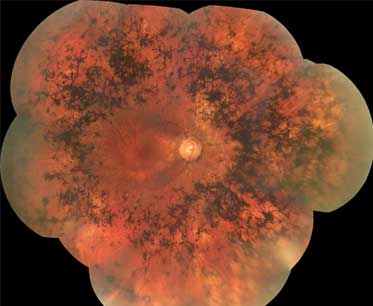Resumo
Definição
História e exame físico
Principais fatores diagnósticos
- presença de fatores de risco
- redução da visão periférica
- cegueira noturna
- comprometimento da adaptação ao escuro
- acuidade central reduzida
- atrofia do epitélio pigmentar da retina
- pigmentação em espículas ósseas
Outros fatores diagnósticos
- nervo óptico pálido em cera
- fotopsias
- erro de refração
- catarata
- atenuação vascular retiniana
- edema macular cistoide
- células vítreas
- ofuscamento por luzes fortes
- visão das cores anormal
- ceratocone
- glaucoma
- drusas da cabeça do nervo óptico
- retinopatia tipo Coats
- amaurose congênita de Leber
Fatores de risco
- história familiar
- presença de uma síndrome associada
Investigações diagnósticas
Primeiras investigações a serem solicitadas
- avaliação da acuidade visual
- perimetria total
- eletrorretinograma de campo total
Investigações a serem consideradas
- limiar elevado final de adaptação ao escuro
- tomografia de coerência óptica (TCO)
- teste genético
- imagiologia óptica adaptativa
- autofluorescência de campo amplo de fundo do olho
Novos exames
- sequenciamento completo do exoma
Algoritmo de tratamento
todos os pacientes
Colaboradores
Autores
Mark E. Pennesi, MD, PhD

Professor
Casey Eye Institute
Oregon Health and Sciences University
Portland
OR
Declarações
MEP serves on the scientific advisory board and executive committee for the Foundation Fighting Blindness.
Paul Yang, MD, PhD

Associate Professor
Casey Eye Institute
Oregon Health and Sciences University
Portland
OR
Declarações
PY acted as a consultant for Applied Genetic Technologies Corp in 2019 and was paid for a meeting regarding XLRP gene therapy, for which there was no agreement to disseminate information.
Agradecimentos
Dr Mark E. Pennesi and Dr Paul Yang would like to gratefully acknowledge Dr Richard G. Weleber and Dr Peter J. Francis, previous contributors to this topic.
Declarações
RGW has served as a consultant to Novartis, Pfizer, and Wellstat, is a member of the scientific advisory board for Applied Genetic Technologies Corp, and serves on the scientific advisory board for the Foundation Fighting Blindness (the relationship has been reviewed and managed by Oregon Health & Science University). RGW also reports having received grants and personal fees from the Foundation Fighting Blindness and Applied Genetic Technologies Corp, and other support from Sanofi-Fovea, all outside the submitted work. In addition, RGW has a patent (US patent 8,657,446, Method and apparatus for visual field monitoring, also known as Visual Field Monitoring and Analysis, or VFMA, which has not been issued). PJF declares that he has no competing interests.
Revisores
Scott Fraser, MD, FRCS (Ed), FRCOphth
Consultant Ophthalmologist
Sunderland Eye Infirmary
Sunderland
UK
Declarações
SF declares that he has no competing interests.
Elias Traboulsi, MD
Professor of Ophthalmology
Director
Center for Genetic Eye Diseases
Cole Eye Institute
Cleveland Clinic
Cleveland
OH
Declarações
ET declares that he has no competing interests.
Referências
Principais artigos
American Academy of Ophthalmology. Comprehensive adult medical eye evaluation PPP. Nov 2020 [internet publication].Texto completo
American Academy of Ophthalmology. Guidelines on clinical assessment of patients with inherited retinal degenerations - 2022. Oct 2022 [internet publication].Texto completo
Robson AG, Frishman LJ, Grigg J, et al. ISCEV Standard for full-field clinical electroretinography (2022 update). Doc Ophthalmol. 2022 Jun;144(3):165-77.Texto completo Resumo
American Academy of Ophthalmology. Recommendations for genetic testing of inherited eye diseases. February 2014 [internet publication].Texto completo
Artigos de referência
Uma lista completa das fontes referenciadas neste tópico está disponível para os usuários com acesso total ao BMJ Best Practice.

Diagnósticos diferenciais
- Rubéola congênita
- Sífilis
- Deficiência de vitamina A
Mais Diagnósticos diferenciaisDiretrizes
- Guidelines on clinical assessment of patients with inherited retinal degenerations
- Pediatric eye evaluations preferred practice pattern
Mais DiretrizesConectar-se ou assinar para acessar todo o BMJ Best Practice
O uso deste conteúdo está sujeito ao nosso aviso legal